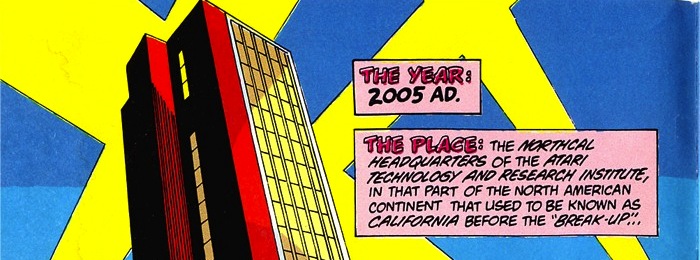And then there are all the Star Wars fans, whose demands will likely be aptly satisfied by Disney.
But before Lucasarts hit on the adventure game, they had to stretch out in a few directions, figure out what was what and what they wanted to do in this new frontier before settling on devastating Sierra at their own genre. This game, with its head-scratching title (which actually is a real word), was part of that early experimentation -- trying to mount a beefier frame on the general skeleton of Rescue on Fractalus!, both proto-FPS games employing fractals to generate landscapes. Before, it was mountains; now, it's cave interiors. (And the rest of us would learn about fractals in '90 when Michael Crichton namedropped chaos theory in Jurassic Park.) Their fractal technology would be trotted out once more, for Koronis Rift.
I didn't have one good scan for this game among my ad archives, so instead I have stolen two, one from my prior source, the excellent World 1-1, and then another from the outstanding Vintage Computing site.
.jpg)
Discover the secrets of The Eidolon, a mysterious 19th century machine powered by the forces of magic. If you can control the powerful energies of this ancient apparatus, an unseen world is yours to explore. The Eidolon lets you teleport and transform enchanted creatures- Greps, Biter Birds and Bottlenecks. And challenge the "intelligent" Guardian Dragons. You can create and capture magic fireballs... perhaps even alter the flow of time itself!Workmanlike, a reproduction of box art and back-of-box copy, plus an obligatory plug by a localized trusted review source. Some people imagine that the trademarking of the enemy names indicated an in-house perception of sequel potential. I dig the way the goofy minor enemies are flying out of the frame; all the same, they speak deeply to me of a game that isn't sure quite what tone it hopes to adopt.
'...outstanding graphics and gameplay' Zzap! 64
Scientific curiosity or passport to a magical dimension?

This is also box copy, but you can tell that they hired someone who could write to crank it out, reaching the hallowed game ad writing metric of: better than it strictly speaking needs to be. Epyx had a hunch that a good way to sell Lucasfilm to Americans would be to evoke Star Wars' opening title credits, and they were probably right. Is this the invention of the "mysterious machinery of disappeared genius" trope in games? Mostly I like this second ad due to the way the colours really pop, though that probably has as much to do with the scanner used and the paper stock printed on as anything else. Epyx's logo and slogan are really something too, however. Someday I should do an "Epyx week" here, but that's a long way away. Next up -- more Lucasarts, but actual scans I made myself. (You can tell by the ridiculously high resolution. Basically, after I scan an ad, no one ever has any need to re-scan it to clarify details ever again.)EPYX PRESENTS
You've just discovered the Eidolon— a curious 19th century machine whose inventor vanished without a trace. Only his journals and sketches remain.
LUCASFILM GAMES
THE EIDOLON
They tell of an incredible magical realm -— a maze of caverns populated by strange creatures noted as Greps, Biter Birds and Bottlenecks. And "intelligent" Guardian Dragons -— who hurl colored fireballs of energy?
The machine itself belies its quaint Victorian charm. For the Eidolon glows with the power of enchanted energy. It awaits, pristine and gleaming -— perfectly preserved for over a hundred years by the powerful forces that propelled it and its pilot to another dimension.
With the fascinating first-person point of view, you can climb into the pilot's chair and fly this mysterious magical machine. And the haunting fractal graphics take you deeper into an endless maze of mystical caverns.
An adventure so real, it'll make you wonder: What ever happened to the Eidolon's mysterious inventor? Only the adventurous of spirit will know his fate. The Eidolon -- scientific curiosity, or passport to a magical dimension?

+extralives.jpg)



